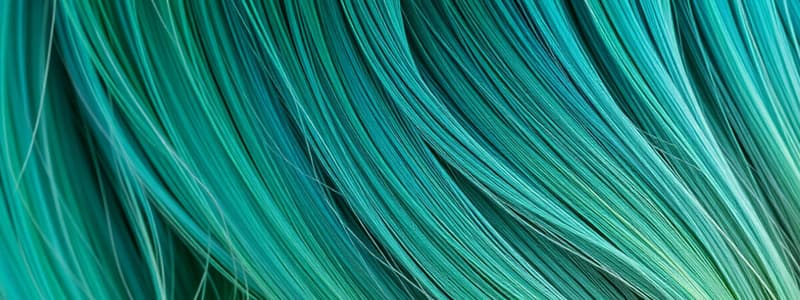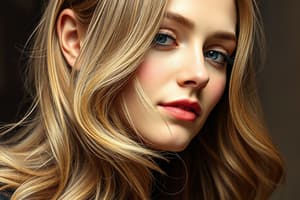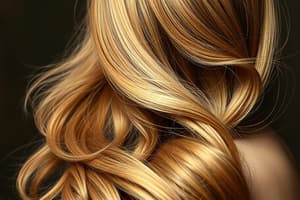Podcast
Questions and Answers
What is the pH range of permanent haircolor products?
What is the pH range of permanent haircolor products?
- 6.0 to 7.5
- 10.5 to 12.0
- 8.5 to 9.5
- 9.0 to 10.5 (correct)
What happens to the cortex of the hair during the haircoloring process?
What happens to the cortex of the hair during the haircoloring process?
- It shrinks and traps color molecules. (correct)
- It expands and loosens.
- It remains unaffected by the process.
- It becomes more porous.
Which type of haircoloring product is most effective for covering gray hair?
Which type of haircoloring product is most effective for covering gray hair?
- Permanent haircolor (correct)
- Highlights
- Temporary haircolor
- Semi-permanent haircolor
What is required before performing a service with oxidation tints?
What is required before performing a service with oxidation tints?
What is the term for the line that develops between new growth and previously colored hair?
What is the term for the line that develops between new growth and previously colored hair?
What chemical must oxidation tints be mixed with to activate the reaction?
What chemical must oxidation tints be mixed with to activate the reaction?
What type of colors can oxidation tints provide in one process?
What type of colors can oxidation tints provide in one process?
Which of the following best describes toners in the context of oxidation tints?
Which of the following best describes toners in the context of oxidation tints?
Flashcards are hidden until you start studying
Study Notes
Permanent Haircolor Overview
- Permanent haircolor products are alkaline, with a pH range of 9.0 to 10.5.
- After application, hair is washed and dries, returning to its normal pH, causing the cortex to shrink and cuticle to close, trapping color molecules.
- Permanent haircolor does not wash out during shampooing; however, it may fade over time and require refreshing.
- New hair growth creates a line of demarcation, necessitating a retouch application of permanent haircolor to blend new growth with previously colored hair.
- Considered the best option for gray hair coverage, permanent haircolor diffuses natural pigments and adds artificial color for uniform blending.
Types of Permanent Haircolor
- Oxidation Tints:
- Also known as aniline derivative tints or penetrating tints, these can lighten and deposit color in one process.
- Available in a wide variety of shades; includes toners designed for use on pre-lightened hair.
- Most products include aniline derivatives and require a predisposition (patch) test prior to usage.
- Compatible with other professional chemical services (waves and relaxers) if the hair is in good condition.
- Available in various formats (bottles, canisters, tubes) as semiliquid or cream.
- Must be mixed with hydrogen peroxide to initiate the oxidation chemical reaction immediately upon mixing.
Studying That Suits You
Use AI to generate personalized quizzes and flashcards to suit your learning preferences.





